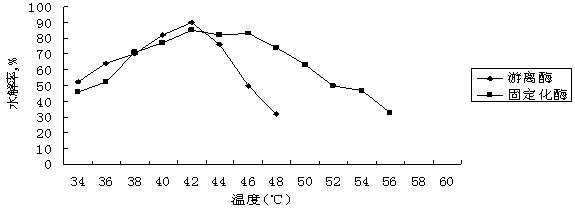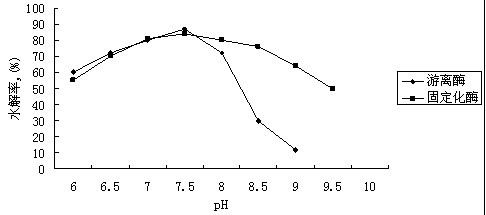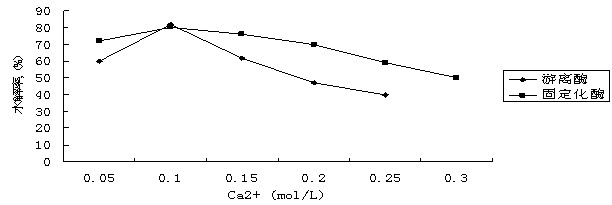Preparation method of immobilized lipase
A technology for immobilizing lipase and lipase, applied in the direction of being immobilized on/in an organic carrier, can solve the problems of affecting mass transfer, blocking enzyme entry, hindering cross-linking reaction, etc. Long service life, low price effect
- Summary
- Abstract
- Description
- Claims
- Application Information
AI Technical Summary
Problems solved by technology
Method used
Image
Examples
Embodiment 1
[0037]The present invention selects natural fiber---ramie as carrier, and three steps of activation of ramie, porcine pancreas lipase liquid preparation and cross-linking are carried out:
[0038] (1) Activation of ramie: cut some ramie, boil with 0.5mol / L KOH for 0.5 hour to remove impurities on the surface of ramie, then oxidize with 0.1 mol / L NaI04 solution, take it out after 6 hours and wash it with deionized water , add glycerol to the surface of ramie and let it stand for 40 min to remove unreacted NaIO4, and wash it with deionized water for later use.
[0039] (2) Preparation of enzyme solution: Dissolve a certain amount of porcine pancreatic lipase dry powder in 50mL of phosphate buffer (0.025mol / L, pH 7.5), stir evenly at 4°C, and centrifuge at 10,000r / min for 10 min , and then take the supernatant and store it in the refrigerator for later use.
[0040] (3) Cross-linking: put the activated ramie in step (1) in an Erlenmeyer flask and cross-link with the enzyme solut...
Embodiment 2
[0042] The present invention selects natural fiber---ramie as carrier, and three steps of activation of ramie, porcine pancreas lipase liquid preparation and cross-linking are carried out:
[0043] (1) Activation of ramie: cut some ramie, boil with 0.8mol / L KOH for 0.6 hours to remove impurities on the surface of ramie, then oxidize with 0.3 mol / L NaI04 solution, take it out after 8 hours and wash it with deionized water , add glycerol to the surface of ramie and let it stand for 50 min to remove unreacted NaIO4, and wash it with deionized water for later use.
[0044] (2) Preparation of enzyme solution: Dissolve a certain amount of porcine pancreatic lipase dry powder in 50mL of phosphate buffer (0.0.500mol / L, pH 7.5), stir evenly at 4°C, and centrifuge at 10,000r / min for 10 min, and then take the supernatant and store it in the refrigerator for later use.
[0045] (3) Cross-linking: Put the activated ramie in step (1) in a conical flask and cross-link with the enzyme soluti...
Embodiment 3
[0047] The present invention selects natural fiber---ramie as carrier, and three steps of activation of ramie, porcine pancreas lipase liquid preparation and cross-linking are carried out:
[0048] (1) Activation of ramie: Cut some ramie, boil with 1.0mol / L KOH for 1.0 hour to remove impurities on the surface of ramie, then oxidize with 0.6 mol / L NaI04 solution, take it out after 12 hours and wash it with deionized water, Add glycerol and let it stand for 60 min on the surface of ramie to remove unreacted NaIO4, and wash it with deionized water for later use.
[0049] (2) Preparation of enzyme solution: Dissolve a certain amount of porcine pancreatic lipase dry powder in 50mL of phosphate buffer solution (0.025-0.500mol / L, pH 7.5), stir evenly at a low temperature of 4°C, and dissolve at a speed of 10000r / min Centrifuge for 10 min, then take the supernatant and store it in the refrigerator for later use.
[0050] (3) Cross-linking: put the activated ramie in step (1) in a con...
PUM
| Property | Measurement | Unit |
|---|---|---|
| diameter | aaaaa | aaaaa |
Abstract
Description
Claims
Application Information
 Login to View More
Login to View More - R&D
- Intellectual Property
- Life Sciences
- Materials
- Tech Scout
- Unparalleled Data Quality
- Higher Quality Content
- 60% Fewer Hallucinations
Browse by: Latest US Patents, China's latest patents, Technical Efficacy Thesaurus, Application Domain, Technology Topic, Popular Technical Reports.
© 2025 PatSnap. All rights reserved.Legal|Privacy policy|Modern Slavery Act Transparency Statement|Sitemap|About US| Contact US: help@patsnap.com



